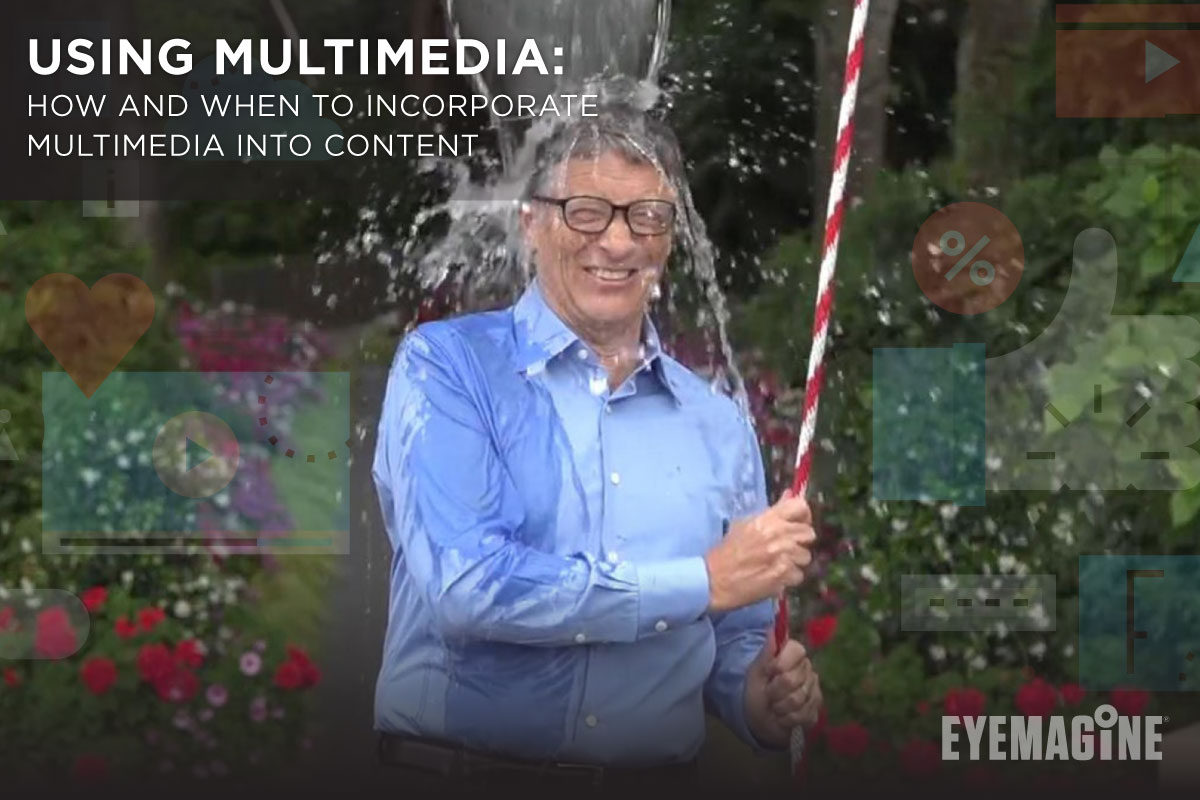
Multimedia can be a unique, useful marketing tool, expanding your engagement and brand awareness in a very powerful way. Here, we break down how and when to effectively incorporate multimedia technology into your content and inbound marketing strategies.
What is Multimedia
Multimedia can take many forms, including:
- Video
- SMS marketing
- Livecasts & Podcasts
- Photo
- File Sharing
The most obvious benefit of multimedia is that it is extremely digestible and shareable - while we hardly see emails or blogs go viral, we see this happen with photos and GIFs every day. It can also evoke a feeling, idea or message more quickly and effectively than blogs, emails or other marketing content.
The Dangers
There are many ways that things can go wrong with multimedia. The main concern is that your efforts will be misguided, using the wrong tool or sending a message that your audience simply is not interested in. Here are the top mistakes to avoid:
- Inaccessible: This has to do with the specific platform or format that you are using. You have to be where your audience is and try to speak in their language. If, say, your target personas are most engaged by photos on Instagram, you would be remiss if you were to share blogs or cartoons on LinkedIn. While this may seem obvious, this is a common mistake: oftentimes, marketers rely on their own instinct or best guess about their audience’s interests rather than the numbers. To get it right, look at the data, conduct surveys, and get an accurate sense of consumer behavior.
- Inauthentic: Buyers can smell inauthenticity a mile away, and these days they are having none of it. If you send out a message that is out of sync with your brand identity, tone, or company values, it will confuse your consumers and break down trust in your brand. For example, in 2012 McDonald’s began their “#McDStories” campaign, with their opening tweet reading: “When u make something w/pride, people can taste it,” McD potato supplier #McDstories
The idea here was to piggyback off of the organic, local eating health craze and work McDonald’s into that “fresh and healthy” narrative. The problem? McDonald’s of the time had no part in that narrative, and consumers were very quick to call them out.
- Unengaging or Misdirected: Your multimedia should highlight one of your most shareable, engaging points and it should be worked into the larger strategy that you’re using. While a beautiful image or a funny cartoon are great, they don’t mean anything if they don’t sum up a key point or evoke some kind of memorable feeling.
How to Get it Right
Figure out who you’re talking to, what they want to see, and where they want to see it. The first step is always to establish your buyer personas and determine their social media habits. What platforms do they visit and what kind of multimedia do they engage with? What kind of learners are they and what information do they find more interesting or useful?

To find this information, you can begin by looking into industry trends and statistics. Next, dig into your company’s metrics and historic data. Where do you see the most engagement? What has worked in the past? What platform is your traffic coming from? This will give you company-specific insights and provide a great starting point for your efforts.
Once you’ve determined this information, you have to pick your message. Each piece of social media content should have a clear purpose and goal. Make sure that this is established ahead of time so that you approach the task with a clear vision and execution.
The Specifics: How to Effectively Execute With Top Forms of Multimedia
Sharing Photos
One of the most obvious - and easiest - forms of multimedia is the photo. Photo sharing can have a variety of ends in mind:
- Link to blogs: Backlinks to your site or to other pieces of content are extremely important for SEO and for extending your brand’s reach. Always try to link back to a call-to-action or a piece of information that your audience will find helpful or useful. Using a photo of a product? Link to that product page to make the purchasing process seamless and easy.
- Drive traffic to your site: The key here, once again, is to generate interest with a thought-provoking, funny or compelling image. Your audience will go back to your site if they want to see more. The higher quality the image and campaign, then, the more likely you are to drive qualified traffic back to your site.
- Foster a sense of community: Consider the viral “Ice Bucket Challenge.” Not only did it raise awareness for a great cause, but it also fostered a sense of community and engagement by presenting a fun, silly activity that people wanted to get involved with. Overall, encouraging communities to share photos or videos is a great way to increase brand engagement and awareness without actually pushing your product or service. You can also expand your reach and your audience by joining like-minded communities and sharing in online groups that may not have otherwise considered your product or service.
- Build brand identity: With photos, you can show your products, staff, etc., in various tones and situations that help mold and shift your brand identity. This could add themes, interests, or touches of humanity that your customers wouldn’t have otherwise expected from your company.
This is particularly useful when combined with effective use of hashtags, alt tags, and themes. Make sure to stay consistent and continuously support your larger goals and strategies.
Sharing Videos
- How-to videos: Show how to use your product or provide another piece of related education. Even a general industry-related how-to video can be productive, as it can widen your audience base and bring fresh eyes to your content.
- Engage: Entertain customers with videos for enjoyment. These don’t even have to be about your product or company - and sometimes it’s actually preferable that they aren’t. Including a “videos we like” section that touches on funny, relatable or interesting content can expand your reach and show off your company’s personality, thereby increasing relatability and encouraging more people to tune in.
- Testimonials & Influencers: In today’s age, social proof goes a long way. People don’t necessarily trust marketers or brands, but they do trust their peers or people that they perceive to be like them. When it comes from these sources, reviews can be powerful and can motivate purchases that a brand can’t bring about on its own.
- Viral Bonus: Make it a meme. Memes are funny, shareable and relatable. The key, once again, is to tap into your audience’s sense of humor and touch a topic that they will find enjoyable or relatable.
Cartoons
Cartoons are an easy, memorable way to explain key concepts or marketing lessons. Tom Fishburne, founder of Marketoonist, put it this way: "When someone thinks to themselves, 'I've been there,' it makes the cartoon funny and evokes an emotional connection [...] When done correctly, we're acknowledging a universal truth and this is where content marketing works best -- more about the reader and less about the brand. Cartoons lend themselves to this powerful approach."
This can bring big marketing results, providing the audience with an interesting, easily-digestible piece of information that they can share, save and continuously draw upon. Look for that relatable, entertaining element and try not to get too heavy on the text.
Music & Podcasts
Some people connect more to audio than to the written word or images. In such cases, some music or an informational podcast can be extremely useful for marketers. Just remember to keep it on-brand and informative.
When properly executed, multimedia can be a powerful, different marketing tool. Use it to switch up the conversation and expand your brand’s reach.
Image Credit: https://www.youtube.com/watch?v=XS6ysDFTbLU


